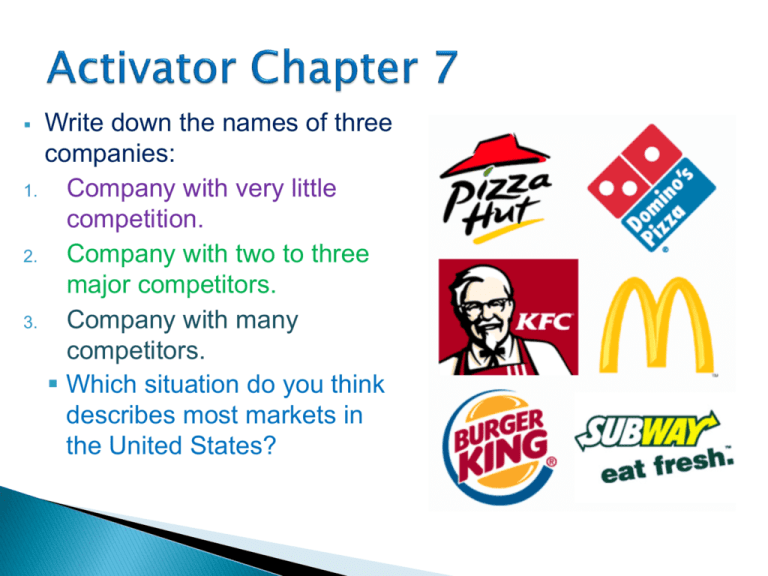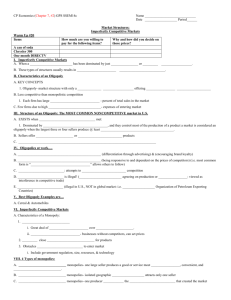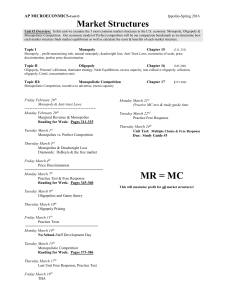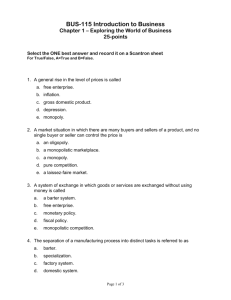Monopoly - Glynn County Schools
advertisement

Write down the names of three companies: 1. Company with very little competition. 2. Company with two to three major competitors. 3. Company with many competitors. Which situation do you think describes most markets in the United States? Perfect Competition – also known as pure competition, large number of firms producing essentially the same product (most competitive) No participants are large enough to have the market power to set the price of a product. Buyers and sellers are so numerous that no one buyer/seller has any influence over the market price Firms are thus price takers Price is determined purely by supply and demand Four Conditions: 1. Many buyers and sellers 2. Goods offered for sale are exactly the same/identical 3. Buyers and sellers have access to information about products 4. Sellers are able to enter the market freely; no barriers to entry Commodity - basic good with little differentiation from one product to the next with multiple producers selling the same product Tomatoes Oranges Wheat Corn Onions Plants/trees Crude Oil Stock Market Monopoly - when one company controls the market of a good/service and can effectively dictate prices(least competitive) Microsoft (90’s), NFL, China’s Pandas, Comcast, etc. Complete barrier to entry Government Monopolies – a monopoly intentionally created by the government Patent – gives a company exclusive rights to sell a new good or service for a specific period of time Copyright – the right to control the written word, intellectual property such as lyrics, music, logos, slogans, etc. Franchise – the right to sell a good or service within an exclusive market (cable TV, power company, water, etc.) License – a government issued right to operate a business (liquor license, gasoline, etc.) Price discrimination – dividing customers into groups and charging each customer a different amount Market Power – ability to control prices and total market output Monopolistic Competition – many companies selling similar products but not identical Market for Jeans in the U.S. Four Conditions of Monopolistic Competition 1. Many firms 2. Few artificial barriers to entry 3. Slight control over price 4. Differentiated products (main difference between perfect and monopolistic competition) Oligopoly – a market structure in which a few large firms dominate a market; a few of the largest firms produce at least 70-80% of the output. Automobile industry, commercial airlines, beer industry, cartels, web browsers, smart-phones, etc. Characteristics: High Barriers to Entry Collusion – businesses work together to price fix, agreement to set prices Price Fixing – agreement among firms to sell at the same or very similar prices Cartel – a formal organization of producers that fix prices and control supply (OPEC) Rules of the game: •Monopolies occur when a player acquires all of one property color or all of the utilities 1. Once a player has declared their monopoly to the government, a monopoly can charge any price they wish for their properties (price discrimination may occur). 2. The government (Coach L) must be notified of any monopoly. 3. Other members of the market (other players) can voice complaints to the government regarding unfair price increases or inconsistent monopoly practices. 4. Responses to complaints can include fines, restrictions on ability to operate for certain amounts of time (ie: monopolies can only occur for two turns around the board), price ceilings or in extreme cases, jailings or breaking up of monopolies. •Oligopolies can form when a group of two or more players have all the properties of one color between them. 1. As an oligopoly you can charge any price you wish for your properties; you ALL must agree on the price. 2. Once you set the price, you may not change it until two rounds have passed. Rules of the game: •Monopolies occur when a player acquires all of one property color or all of the utilities 1. Once a player has declared their monopoly to the government, a monopoly can charge any price they wish for their properties (price discrimination may occur). 2. The government (Coach L) must be notified of any monopoly. 3. Other members of the market (other players) can voice complaints to the government regarding unfair price increases or inconsistent monopoly practices. 4. Responses to complaints can include fines, restrictions on ability to operate for certain amounts of time (ie: monopolies can only occur for two turns around the board), price ceilings or in extreme cases, jailings or breaking up of monopolies. •Oligopolies can form when a group of two or more players have all the properties of one color between them. 1. As an oligopoly you can charge any price you wish for your properties; you ALL must agree on the price. 2. Once you set the price, you may not change it until two rounds have passed. •Borrowing and Saving: 1. You might want to determine a way to incorporate the principles of the saving and lending into your market. Example: 1. The center of the board acts as the loanable funds market. 2. Each round you must alternate as a saver and a borrow. 3. Government policies state that you can save 10% of your gross income; you can borrow up to 30% of your income (saved money can be collected 3 rounds after it is saved, borrowed money must be repaid + interest after 4 rounds from the time borrowed). 4. After each player has completed a round, the interest rate will be set based up on the amount of loanable funds in the market (i.e. 200 – 10%, 300 – 8%, 500 – 5%, 1000 – 2%, etc. 5. One person should keep track of the loanable funds that are borrowed and saved each round and payouts to players (this money should come from the loanable funds market or the bank). Chapter 7 – Market Structures Monopoly Game Rules of the game: •Monopolies occur when a player acquires all of one property color or all of the utilities 1. Once a player has declared their monopoly to the government, a monopoly can charge any price they wish for their properties (price discrimination may occur). 2. Monopolies will be regulated by the government. 3. Any player holding more than one monopoly should be notified by the market to the government for their unique ability to influence or control the game; this may increase government oversight. 4. Other members of the market (other players) can voice complaints to the government regarding unfair price increases or inconsistent monopoly practices. 5. Responses to complaints can include fines, restrictions on ability to charge certain players, restrictions on ability to operate for certain amounts of time (ie: monopolies can only occur for two turns around the board, or until a certain amount of money has been made), price ceilings or in extreme cases, jailings or breaking up of monopolies. •Oligopolies can form when a group of two or more players have all the properties of one color between them. 1. As an oligopoly you can charge any price you wish for your properties; you ALL must agree on the price. 2. Once you set the price, you may not change it until two rounds have passed. •Government Regulation: 1. The government will intervene on its own, or respond to complaints from players throughout the game. 2. A complaint should come from overpricing, crooked business deals and unfair business practices. 3. Lottery will be all the fines throughout the game place in the center of the game board. Item Tic-Tacs Characteristic Number of of the Item Firms Identical Jolly Ranchers Slight difference Tootsie Pops PayDay Slight difference One Item Market Structure Examples in the Real World Many Perfect Competition Commodities (Onions, Oil, Gold, etc.) Many Monopolistic Competition Jeans, Watches, Fast Food, etc. A Few One Oligopoly Monopoly Auto/Airline industry, Web Browers, etc. Microsoft, NFL, Comcast, China’s Pandas, etc. Reflection Questions Monopoly 1. Has anyone formed a monopoly or oligopoly? Explain how this has affected the game. 2. How can monopolies/oligopolies affect the real economy? Explain. 3. Has anyone used the concept of price discrimination? What are examples of this in the real world? 4. How did government regulation affect the game; who gained who lost? 5. What makes a monopolistically competitive market structure different from a perfectly competitive market structure? Government Regulation 1. Redistribution of Wealth - the top 2 earners for each market must pay a 10% tax to each additional member of group (ex. $2000, $200 to each member) 2. Government Stimulus - The poorest 2 members of the market are awarded a stimulus of $1000, the rest of the members receive a stimulus of $500 3. Taxes on the Rich - The player with the most properties must pay $100 tax to each member of the group Government Regulation 1. Each person involved in a monopoly must forfeit one of their properties back into the pool. Each member receives $200 stimulus. 2. Tax cuts for the rich: the two richest members of the group receive $500 each, the remaining members have to pay $100 to the middle of the board. 3. Each member of a monopoly must pay a one time tax of $500 to the center of the board. Additionally, they are to serve 1 rounds in jail for abusing market power. Record the Following 1. Position on the board 2. Money for each player 3. Money in the Lottery 4. Properties owned and houses built 1. 2. 3. 4. 5. 6. Describe the four examples of price discrimination listed in the book (targeted discounts, pg. 163) Define Nonprice competition (167). Describe the four examples of nonprice competition (pg. 167-168) Describe the four conditions of monopolistic competition (pg. 167) Define cartel (171). Define antitrust laws and trust (173). Condition Description 1. Many Buyers and Sellers Many firms, no firm can gain an advantage in the market 2. Identical Products No difference between the products sold by different suppliers 3. Informed Buyers and Sellers People know what they should be paying for the product. 4. Free Market Entry and Exit Easy to enter or leave the market Example(s) Agricultural industry, stock market Commodities, tomatoes, corn, low-grade gasoline, notebook paper, and milk (tic-tacs). Buyers incentive to save is based on time spent to gather info. Market for frozen dinners Condition Description 1. Discounted Airline Fares Cheaper rates for certain fliers. 2. Manufacturers Rebate Offers 3. Senior Citizen or Student Discounts 4. Children Fly or Stay Free Promotions Example(s) Cheaper rates for buying in advance, spending a Saturday night. Receive money back from the supplier. Refrigerators, cars, tvs, etc. Lower rate for older/younger people. Zoos, theaters, restaurants, etc. Lower rates for families with children because they travel less. Food discounts (kids eat free), clothing, school expenses, vacations, etc. Condition Description 1. Physical Characteristics Brand differentiation based on size, color, shape, texture, taste, etc. Running shoes, pens, cars, toothpaste, jeans, etc. 2. Location Goods can be differentiated based on where they are sold. Gas stations, movie theaters, scarcity of land. Sell for a higher price, because of their high level of service. Restaraunt vs. fast food, Publix, Disney, etc. Advertising can create differences between products. Hanes vs. Fruit of the Loom t-shirt. 3. Service Level 4. Advertising, Image or Status Example(s) Statement Concept (s) Explanation 1. Jane can purchase a share of Microsoft stock from Smith Barney or Schwab. There is no difference in the price of the product. Perfect Competition Identical Products 2. GM, Ford and Chrysler comprise 80% of the market share for automobiles. Oligopoly Few companies have market power 3. It is nearly impossible to compete with the NFL . Monopoly 4. In the market for cell phones, there are a number of different companies to select from. Monopolistic Competition One company has market power 5. OPEC controls the world’s supply of oil. Cartel, Collusion, Price-fixing 6. Cilantros offers free meals to children Price under 12. Discrimination 7. Publix uses the slogan, “where shopping is a pleasure”, to differentiate their products. 8. Microsoft used its market power to illegally force companies to not use Netscape browsers. Non-Price Competition Anti-trust laws Similar but different products Several businesses collude to control prices Companies charge different prices for different consumers Service levels differentiate or other non-price factors to appeal to the consumer Microsoft used their market power to illegally push Netscape out of business Perfect Competition Monopolistic Competition Oligopoly Monopoly Number of Firms Many Many A Few One Variety of Goods None Some Some None Control Over Prices None Some Some Complete Low High Complete Barriers to Entry Examples None Commodities – Agriculture, Stocks Jeans, Fast Food, Toothbrushes Automobile/Airline Industry, Smart Phone, Web Browsers Microsoft 90’s, NFL, Cable What is a trust similar to? 2. What law prevents monopolies and mergers that limit trade? 3. How have some companies used strategies to control their market? 4. What was the end result of the antitrust case against Microsoft? 5. What major companies were broken up by the government? 6. What merger was denied in 1997? 7. What does deregulation refer to? 8. What are some industries that have been deregulated? 9. How did deregulation affect some states in the 1990s? 1. 1. Perfect Competition 2. Monopoly 3. Patent 4. Oligopoly 5. Collusion 6. Monopolistic competition 7. Sole Proprietorship 8. Partnership 9. Corporation 10.Price Discrimination 11.Market Power 12.Cartel Perfect Competition 2. Many buyers and sellers, identical Products (price takers), informed consumers/sellers, low barriers to entry (enter and exit easily) 3. Barriers to entry 4. Monopoly 5. Natural 6. The monopoly can dictate prices (unstable) 7. Patent 8. Government 9. License 10. Price discrimination 11. Market power 12. Monopolistic 13. Many firms, low barriers to entry, brand differentiation, slight control over price 14. Physical characteristics, location, service level, advertising image or status 1. 15. 16. 17. 18. 19. 20. 21. 22. 23. 24. 25. 26. 27. 28. 29. Oligopoly Collusion/price fixing Anti-trust Microsoft Business organization Sole proprietor Partnership General Limited Limited liability Articles of partnership Corporation Sole proprietorship Corporation Stock 30. 31. 32. 33. 34. 35. 36. 37. 38. 39. 40. 41. 42. 43. 44. Partnership Sole proprietorship Closely held Publicly held Partnership Corporation Multinational Horizontal Vertical Conglomerate Franchise Cooperative Consumer Service Producer 1. Business Organizations Chart 2. Google Video Questions 3. Market Structures Simulation 4. Chapter 7/8 Study Guide 5. Chapter 7/8 Crossword Puzzle 6. Notes 7. VIS Terms Chapter 7/8 8. Daily Tens 1. Name 2. Date (3-15) 3. Class Block 4. ID: A, B or C 5. Chapter 7 + 8 Test 1. List 5 examples of commodities 2. What are a few things that would make working for Google unique? 3. Which of the 4 market structures does the United States most closely resemble? Explain your answer.









